In our "Dog Training Made Simple" guide, we give dog owners practical tips and tricks for building a loving, trusting, and rewarding relationship with their dog. Properly training your dog will be one of the best investments of time that you can make.
In 2020, 73% of dog owners reported using some form of training method on their dogs, compared to just 57% of owners back in 2018.
Training a dog is no small task, especially if you choose to do so on your own without the help of a professional. Even with professional help, dog training takes time, effort, and dedication.
However, as the saying goes, a trained dog is a happy dog.
Dog training can give your pet clear boundaries that help them better understand you and your surroundings. Plus, training is foundational to building respect between you and your animal — it helps create a system of communication your dog can rely on and trust.
Beginning to train a dog can feel like a big challenge, especially if you are new to training. This guide is here to help you through all of the dog training essentials, from what supplies you need to the different types of training techniques.
In this guide, we have divided the core topics into five main sections:
- Before You Start: 5 Key Considerations Before You Begin Dog Training
- The 5 Core Types of Training: What to Start with & How to Progress
- Proofing Behaviors: How to Solidify Your Training Efforts
- Socialization & Dealing with Aggression in Dogs During Training
- Key Advantages of Working with a Professional Dog Trainer
Get ready to perfect your pooch’s behavior as we jump into your first steps of training.
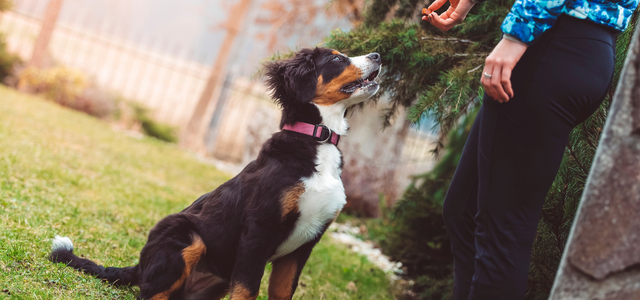
Before You Start: 5 Key Considerations Before You Begin Dog Training
Like all good guides, we have a few words of caution before we begin.
As a dog owner, training your dog can be a bonding experience like no other. However, without the right approach to training, you may end up doing more harm than good.
Here are five essential considerations to think about before you start training your dog:
1. Training Puppies vs. Adult Dogs
The age of your dog makes a big difference in training.
If you are the proud owner of a new puppy, you must remember that puppies have many different energy levels and attention spans than adult dogs. Although you can begin training a puppy as young as eight weeks, puppies require more effort on your behalf when mastering various lessons.
Here is a quick rundown on how to train a puppy:
- Exert Energy First: Puppies have a lot of energy in short spurts. If your puppy is full of this energy, they will have a more challenging time paying attention to you. Giving your pup a chance to play and exert some of this energy before you begin a training session is vital.
- Keep it Short & Frequent: As stated, a puppy’s energy comes in short spurts — and this includes a puppy’s ability to focus as well. When training a puppy, keep your sessions short and sweet but frequent. You want to be constantly reinforcing your lessons.
- Learn Potty Training: The first big lesson you need your puppy to grasp is that the outdoors is where they can go to the bathroom. Most puppies can learn potty training at around 12 to 16 weeks old. Potty training takes patience and consistency — keep an eye on signs your puppy is about to use the bathroom and take them outside immediately. Use a crate and puppy pads when you are not home or are asleep.
- Watch the Biting: Your puppy is going to bite you, and, chances are, you’re going to let them. Playing with your puppy is part of the joy of having such a young animal, and it can be difficult to correct destructive behaviors that come out during that playtime. However, it is important to set the boundary that biting is not okay, especially hard biting. This is essential for your safety, your dog’s safety, and the safety of others.
- Make the Crate a Safe Space: Crates are a crucial part of puppy training, especially during the potty training stage. As such, you want your puppy to feel comfortable and at ease in the crate, which should never be used as a punishment. Adding pillows, blankets, or small beds can make the crate cozier and encourage them not to use the bathroom in the crate.
As for training adult dogs — well, that’s what this guide is here for! This guide can be applied to training puppies and adult dogs. Just remember the above tips if you are training a puppy.
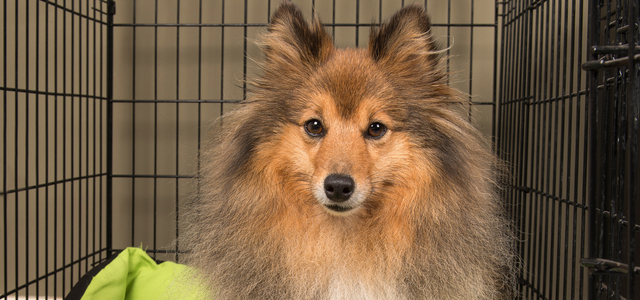
2. Supplies & Resources You Need for Training
You can begin training if you don’t have the proper supplies.
Having the right training accessories is essential for your training success. It also ensures your dog has the right resources and reinforcement to get the most out of their training sessions.
Here are the necessary supplies for training a dog:
- Crate: Having a crate is helpful for both puppies and adult dogs in training. Crates can be used for several purposes, including creating a safe space for anxious dogs and teaching dog boundaries within your home. Just remember that crates should not be used as punishment, as doing so can make your dog fearful of the crate.
- Puppy Pads: For potty training, both puppies and adult dogs, make sure you have some puppy pads on hand. These disposable pads stick to your floor for your pet to use inside the house. Puppy pads should not be used as a solution to potty training but rather as a key potty training supply that helps minimize the mess.
- Leash, Collar, & Harness: Your leash, collar, and harness are the three core training tools. A collar is where you will place your dog’s name and vaccine tags, as well as information on how to contact you should they get lost. The harness is for walking and training your dog, as it gives you greater control over your dog, and the leash is how you will lead your dog.
- Training Treats: As we will cover briefly, positive reinforcement is vital in successful dog training. Designating a “training treat” will help you to reward your dog for mastering lessons and demonstrating good behavior while withholding these treats is how you will communicate a lesson failure or an instance of bad behavior.
3. Exercise & Energy: Getting Your Dog in the Learning Mindset
In our tips for training puppies we discussed earlier, we touched on the importance of exerting a puppy’s energy before beginning a training lesson.
The same is true for adult dogs as well — you need to exert their energy before training.
Dogs, especially younger ones between the ages of one to five, have a lot of energy. Certain breeds are known for being highly energetic, such as Border Collies and German Shepherds, and require a fair amount of physical and mental stimulation.
If you try to train a dog before their daily exercise, you’re likely to wind up frustrated and on the verge of quitting. Comparatively, if you schedule your training sessions after your dog has had some exercise, you may just find yourself teaching a much-improved student.
Most dogs require between 30 minutes to an hour of vigorous activity per day, though larger and more energetic breeds can require between one to three hours per day.
4. The Role of Positive Reinforcement in Dog Training
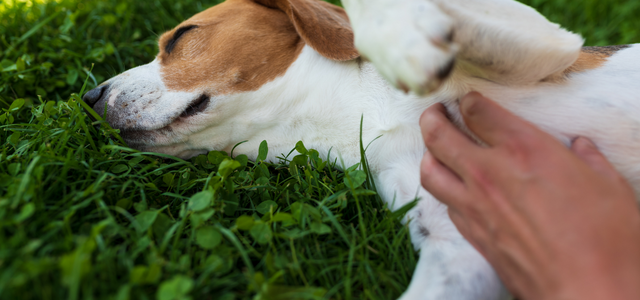
Over the years, humans have tried out all sorts of different training techniques on dogs, including some highly questionable methods that include physically harming or verbally abusing a dog for bad behavior.
As you might guess, these aversive methods have not proven to be effective.
What has been proven to work is positive reinforcement. In a 2020 study that compares the use of electric collars (an aversive method) to positive reinforcement (a reward method), the study found that positive reinforcement was “more effective at addressing the target behavior as well as general obedience.”
Depending on your outlook and experience with dogs, you may or may not favor using physically-based, aversive punishment in your training.
Let us be clear that research and professional experience recommend positive reinforcement only.
5. Human Training: Getting Yourself Ready to Lead
Finally, the last step when preparing to start training your dog is to prepare yourself.
To train a dog, you will need the following:
- Patience: There’s no denying that there is a language barrier between dogs and humans. Building a communication system between you and your dog takes a lot of patience and repetition. Stick with it, and when you see your dog start to understand you, you will feel the rewards.
- Time: Training a dog does not happen overnight — some might even say that owning a dog is a lifelong training process. Your dog can learn, but they need consistency on your end, which takes a sizeable time commitment in your schedule.
- Dedication: Perseverance and dedication are crucial to training a dog! You have willingly entered into the role of teacher for your animal, so make sure you maintain a sense of dedication to the cause. With your dedication, your dog is given the best opportunity to shine.
The 5 Core Types of Training: What to Start with & How to Progress
You’ve passed the first steps of training, and you’re ready to start teaching your dog the ways of the well-behaved pooch — so where do you start?
Here are the five core types listed in our recommended order of completion:
1. House Training
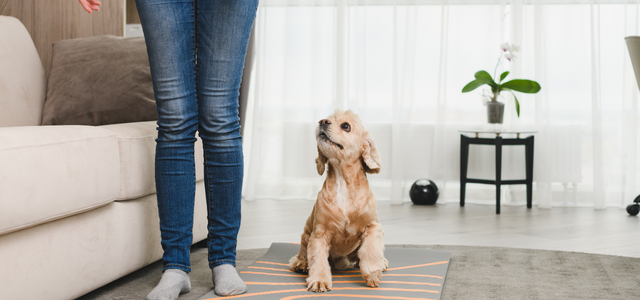
House training a dog is often equated with pottying training a dog, but it encompasses so much more than that.
Potty training is just one component of training a new puppy or adult dog. A good house training strategy should also strive to:
- Establish house rules and clear expectations: House rules are sometimes overlooked but incredibly important when training a dog. Having rules for your dog that apply within your home teaches them to respect your space and listen to you as an authority. An example of one such rule is teaching your dog not to bark at random noises and passers-by.
- Set boundaries for dog-friendly areas of the home: When first beginning training in your home, a dog will not immediately understand that your entire home is not their stomping grounds. Using baby gates and barricades to block off certain areas of your home, as well as keeping specific doors closed, can help you to set physical boundaries for your dog.
- Create a safe space your dog feels secure in: Having a home that a dog feels comfortable in is essential for building a trusting relationship with your animal. You want your dog to think of your home as their home, and you should create a space specifically for your dog that acts as their personal safe space in your home. This can be a dedicated spot for a bed, a crate, or other items.
2. Focus & Attention Training
After potty training, many dog owners conclude that the next type of training to complete is leash training — wrong!
A crucial step between potty training and leash training is attention training. This type of training teaches your dog to pay attention to you when you speak, which becomes one of the most important skills for your dog to utilize throughout all other training.
The easiest way to do this is to teach your dog the command, “Watch Me.” Alternatively, you can use the command “Look” as your attention training word. Whichever phrase you pick, make sure you stick to it.
Consistency is key!
As for how to teach your dog this command, follow these steps:
- Using a treat, hold the treat at your eye level and give your dog the attention command of your choice. This is how you will teach them where to look. When their eyes lock onto the treat, give them the treat and repeat this process.
- When your dog is automatically looking at the treat you are holding at eye level, hold the treat behind your back while still holding your hand as if you are holding the treat in front of your face. This is how you will begin to remove the treat from the equation. Once again, give them the treat after they successfully look at you, but make it more obvious the treat is coming from behind you. You will need to repeat the first two steps quite a few times before moving on to step 3.
- Remove your hand from in front of your place and keep it in a neutral position either at your side or behind your back. Keep the treat behind your back as well. Give your dog the attention command with nothing in front of your face. If your dog looks up to your eyes, reward them and repeat this process. If they never look, you may need to return to steps 1 and 2.
- After your dog has mastered looking directly at your eyes and face without anything held in front of your face, it’s time to start eliminating the treat. Your goal is to have your dog complete the command with or without the treat, so start limiting the frequency of your treat rewards. However, you should still reward your dog; just do so with verbal praise and pets.
Having a command that signals your dog to look directly at you and listen to you is a major game-changer when it comes to dog training. You should begin practicing this command as early and as frequently as possible to make it the very first trick your dog masters.
3. Leash Training
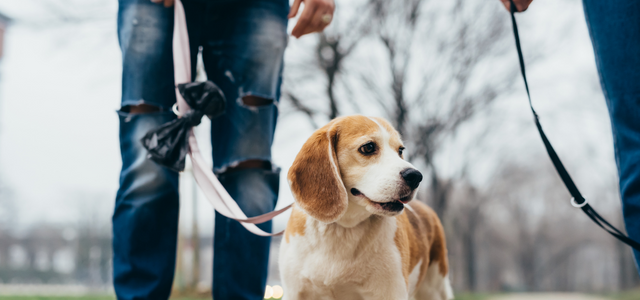
Leash training is next on your to-do list, though you have likely already started to some degree.
Unless you have a fenced-in yard at home, on-leash walks are a necessity for taking your dog to the bathroom and letting them get exercise. Even before you formally begin training, you will be walking your dog around your neighborhood on a leash.
As such, there are a few leash basics to know from the get-go:
- Harnesses give you greater control over your dog’s body and make pulling more difficult.
- Flat leashes are the most sturdy leash for handling an untrained dog.
- Keeping your dog close to you and not at the entire length of the leash puts in the early work for stopping pulling behavior later on.
When you are ready to start formally leash-training your dog, you will follow these steps:
- Stand outside with your dog on a leash and begin practicing the attention command (see why we learned that first?). This will not only help reinforce the attention command but will also help you to keep your dog’s attention focused on you before you begin a walk.
- Begin walking slowly over a short stretch of ground. For example, you could walk up and down a parking lot or in a loop in your backyard, repeating the same loop repeatedly. This accomplishes two things — it gets your dog used to their surroundings, and it gives you a chance to practice in a more controlled environment. While walking loops in this small area, stop walking when your dog pulls on the leash. Give the attention command (if they have mastered it yet) and reward them when they look at you, and there is slack in the leash.
- Repeat this stop-and-look process on your small walking loop. This will make up the majority of your training sessions for the first few days as your dog learns not to pull on the leash and to continue following the attention command while around outdoor stimuli.
- When your dog can calmly walk the loop without pulling on your leash and is showing good progress with listening to the attention command while outside, begin taking longer and farther walks. This introduces new stimuli and distractions that will likely make you need to repeat the stop-and-look process quite a bit on your first few longer walks.
- Increase the duration, length, and frequency of your walks slowly as your dog gets the hang of walking on the leash. We recommend working up to a long walk with no pulling over for at least a month, though you should begin seeing progress with the pulling within a week.
4. Command Training
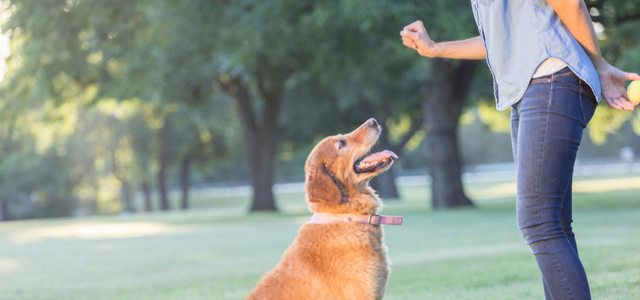
Command training is likely to overlap with all other types of training, as you will be teaching your dog all sorts of different commands. You already taught one — the attention command!
Like leash training, you will probably start practicing your basic commands when you get your dog. However, as a word of caution, we recommend being highly intentional with your command training and incorporating it into your training sessions rather than trying to teach them along the way passively.
The seven core commands to teach your dog are:
- The Attention Command: The attention command is used to get your dog’s attention and make them look at you. “Look” or “Watch Me” both work as attention commands, though a dog’s name can be used as an attention command as well.
- The “No” Command: The “No” command is essential for training, as it informs your dog that they have done something terrible. This is one of the only instances of positive punishment you should use — a single calm but firm “No” that tells the dog to stop what they are doing.
- The “Come” Command: The “Come” command is incredibly important, as it directs your dog to come to you. This command can be tricky, as your dog may master it within your home and then ignore it entirely in outdoor off-leash situations. Thus, this command is very important to practice regularly both indoors and outdoors, even when on a leash.
- The “Sit” & “Lie Down” Commands: The “Sit” and “Lie Down” commands take your dog from an active position to a passive one. These commands are handy when trying to calm your dog down or control their behavior.
- The “Stay” Command: The “Stay” command demonstrates your dog’s ability to stay in a sitting or standing position in the spot that you indicate. To master this command, your dog should be able to maintain the “Stay” position until you release them from it, even if you walk entirely out of their sight range.
- The “Drop It” Command: The “Drop It” command is what you will use to get your dog to open their mouth and release something they are holding onto. This can be useful when playing catch and crucial for their safety if your dog eats something dangerous.
- The “Heel” Command: The “Heel” command is used as a component of both leash training and off-leash training. It teaches your dog to come to your side and stay by your side while moving. This is a fairly advanced command and can take the longest time to master the core commands.
In terms of how to teach your dog these commands, you must use the same method we used when learning the attention command:
- Use a treat to elicit the correct response to the command
- Remove the treat from sight when giving the command, using your hand as the new marker
- Remove your hand as a marker and use only the verbal command
The essential part of command training is consistency — both in words you use as commands and the frequency you use them. Keeping your dog on their toes and constantly practicing various commands is the best way to get these commands to stick.
5. Advanced Training
Once you have progressed through the first four types of training and are satisfied with your dog’s progress, you can then choose to continue to advanced training.
Advanced training is not for every dog owner, as it takes twice as much time and commitment and can often be twice as hard to master.
Advanced training can include:
- Off-Leashing Training: Off-leash training is the most common type of advanced training for the average dog owner to pursue. This type of training teaches your dog to listen to your commands and follow your instructions when not on a leash. Learning the “Heel,” “Come,” and “Stay” commands are a crucial first step in this training process, as you need the ability to command your dog to stay by your side no matter what.
- Performance Training: Performance training refers to advanced tricks, acrobatics, and other skills learned for performance purposes, such as dog shows. Teaching performance tricks can also be a great way to keep your dog in shape, especially if your outdoor exercise space is limited.
- Service Dog Training: Finally, you can train your dog to be a service dog. This is a particular type of training that is much more intensive and requires certification. Certification also requires you to qualify for a service animal. If you do qualify and receive the certification, this provides you with special privileges for bringing your dog into public spaces. For those who need a service dog but do not feel comfortable providing this training, you can work with professional trainers to give your dogs the skills they need to fulfill this role.
Proofing Behaviors: How to Solidify Your Training Efforts
Proofing behaviors is practicing your dog’s learned skills in different environments.
For instance, once you teach your dog the attention command and they can successfully perform it every time while indoors, you can proof this behavior by progressing to practicing the command outdoors.
By proofing behaviors, you can slowly introduce new stimuli and distractions into your training and teach your dog to pay attention to you and follow your commands at all times.
Here are five steps for proofing your dog’s behaviors:
- Keep it Slow & Steady: Proofing can be slow and ongoing. You can’t just take your dog to a public park once and consider their newly learned training to be proofed. To proof your training the right way, you need to consistently reinforce positive behaviors throughout the day, not just during training sessions.
- Don’t Introduce Too Many New Distractions at Once: Introducing too many distractions at once will send your dog into a frenzy and make it immensely difficult for them to focus on and listen to you. This is why it is important to take baby steps towards visiting large public areas — first at home and slowly move outside to quieter areas before going around busy places with lots of noise, people, and other dogs.
- Focus on One Behavior at a Time: When proofing behaviors, focus specifically on one behavior at a time. While you should continue reinforcing all good behaviors and training, dedicate your proofing sessions to one specific behavior, such as not pulling on the leash or listening to the “Sit” command.
- Plan Intentional Proofing Sessions: Though proofing is an ongoing process, it should also be an intentional component of your training sessions. Build proofing into each of your training sessions at the end or beginning of a session. You can even schedule some sessions dedicated entirely to proofing previously-learned behaviors.
- Know When to Go Back a Few Steps: Proofing works best when your dog has mastered a skill under normal circumstances. If it becomes apparent during your proofing sessions that your dog still needs more time in training for a specific skill, back up a few steps and make sure your dog has a clear understanding of what you want from them and what the rules are.
Socialization & Dealing with Aggression in Dogs During Training
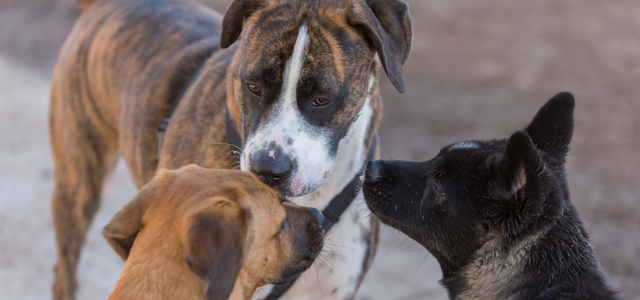
Socializing your dog early is a critical factor in ensuring your dog can behave safely around other people and animals. If your dog is still in training, too much socialization can be too distracting.
However, a lack of proper socialization in dogs can lead to fear and even aggression if left unaddressed.
Aggressive or reactive behavior can develop in dogs for a multitude of reasons, including:
- Fear, anxiety, and/or overstimulation
- A lack of proper, supervised socialization
- A lack of training
Of these potential causes, fear tends to be the most common reason behind an aggressive dog’s behavior.
Remember earlier when we discussed the importance of setting rules and boundaries for your dog, as well as creating a safe space in your home for them? Well, here’s where those steps come into play.
Unless your dog has underlying health or mental conditions that affect their aggression levels, your dog’s general attitude is most directly impacted by you and your home.
In a home where a dog has clear rules and feels at ease, that dog is likely to feel more secure and confident than a dog with inconsistent experiences.
Moreover, dogs can feed off of their owner’s behavior. If you appear weak or fearful, your dog may feel like they need to step up to the plate and enter the role of protector. This can bring about possessive and territorial behaviors that make it hard for your dog to be around people and animals.
As such, along with creating a home space that puts your dog at ease, you must establish yourself as an authority in your dog’s life. Your dog does not take care of you; you take care of your dog. You need them to understand this core lesson — that you are the caretaker in this relationship.
For owners currently dealing with aggressive or reactive dogs, we feel for you and understand you likely just want the best for your animal. Training away aggressive habits can be more complicated than regular training, making working with professional dog trainers highly beneficial.
This leads us to our next and final section, the advantages of professional trainers.
Key Advantages of Working with a Professional Dog Trainer
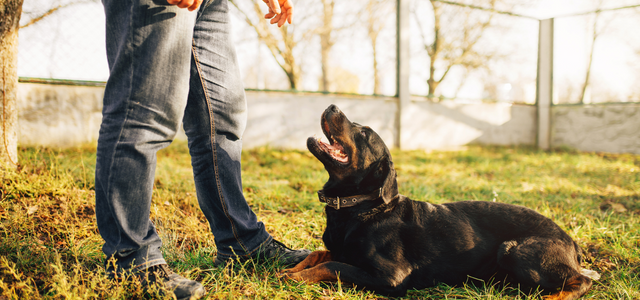
If you have made it to this point in the guide, you have likely come face-to-face with just how much work is involved with dog training. While many dog owners feel it is their sole responsibility to train their dogs in the ways of the well-behaved pooch, it is important to acknowledge the role of the trainer in this equation.
Hundreds, if not thousands, of people turn to professional dog trainers every year for assistance in building better habits for their dogs. For the average adult, learning the ins and outs of dog training at a professional level is simply not realistic with a full-time job and adult responsibilities — so why not turn to the very people who practice dog training as a full-time job instead?
There are many advantages to working with a professional dog trainer, including:
- Controlled Environments: Professional dog trainers have the resources to create controlled training environments ideal for dogs of all experience levels. This is essential in the early stages of training when you need your dog to initially master their basic skills, such as basic commands and walking on a leash.
- Seasoned Expertise: Working with a professional dog trainer means you are getting years of training and workplace experience from a person who has likely worked with all manner of dogs. This is far more experience than the average person, making a professional trainer’s knowledge incredibly valuable for all dog owners.
- Body-Language Analysis: One key aspect of dog training that professional dog trainers specialize in is understanding and interpreting a dog’s body language. Minor movements and expressions can speak volumes about what a dog is thinking or feeling, and having a trainer there to tell you precisely what your dog’s body language could mean is vital.
- Owner Training: Arguably more important than their ability to train your dog is a professional trainer’s ability to teach you. Along with teaching your dog the skills they need to master good behaviors, professional dog trainers can teach owners how to conduct themselves as an authority to their dogs. This can include how to speak, stand, and more.
- Ongoing Support: By working with a professional dog trainer, you ensure that you always have ongoing support throughout the training process. Every dog is different, and your dog will have a unique journey with training. Having a professional dog trainer on standby to help you navigate the hiccups and challenges can be very important.
Final Thoughts: Get Professional Dog Training Help in Edmonton
For dog owners living in or near Edmonton, work with The Leash Team for your dog training needs.
The Leash Team is a highly reputable team of certified dog professionals based in Edmonton, offering a variety of key services, such as:
- Dog Walking: The Leash Team’s certified dog walkers and trainers take great care of Edmonton’s dogs. For dog walking services, both on-leash and off-leash walking options are available. Plus, your dog can have the opportunity to socialize with other pups.
- Dog Walking Adventures: To keep your dog in exceptional shape, The Leash Team offers dog walking adventures that include more vigorous activities, such as hiking. These walks are a minimum of 8 km in length and include dog picnics, dog games, and photos for the owners.
- Private Dog Training: For training help in Edmonton, consider The Leash Team’s private dog training services. These services include both basic and advanced training options, as well as the option to have puppy training as well.
The Leash Team is a proud member of Pet Sitters International, and our dog professionals are certified in Cat & Dog First Aid and CPR.
Visit The Leash Team's dog training page to learn more about our certified, professional dog trainers and dog training services. Or contact the team to learn more.